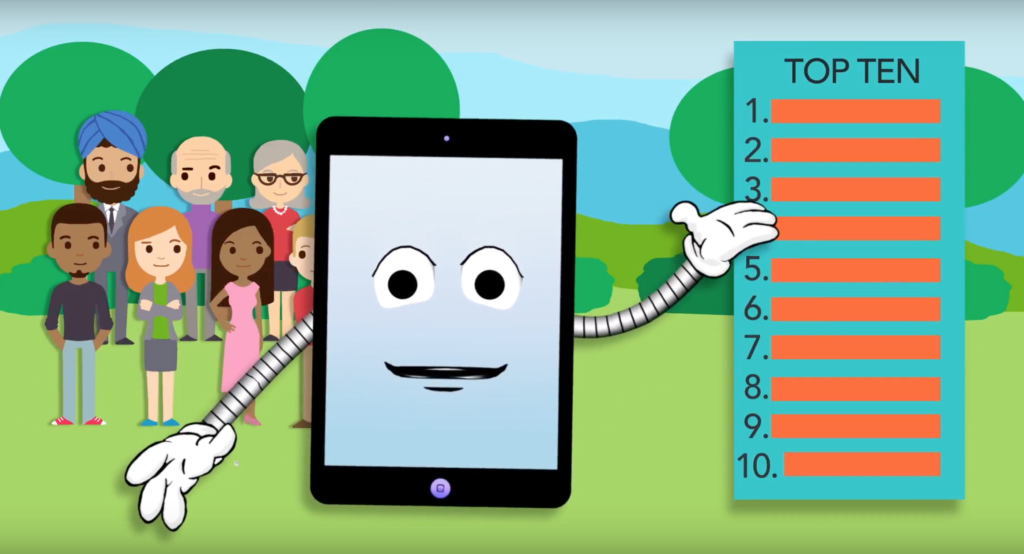
The potential of digital health solutions like online therapy or smartphone apps often belies their complexity. Even as digital health first emerged into the healthcare landscape around 2011, a NIMH sponsored workshop astutely noted “Although these technologies may be appealing and seemingly innocuous, research is needed to assess when, where, and for whom mHealth devices, apps, and systems are efficacious.” (Kumar et al, 2013). Now seven years later these same questions remain and are especially pressing for digital mental health.
A new paper, entitled “Identifying research priorities for digital technology in mental healthcare: Results of the James Lind Alliance Priority Setting Partnership” in Lancet Psychiatry (Hollis et al, 2018) provides an update on the current state and next steps necessary for realising the true potential of digital mental health.

The aim of the Digital Technology for Mental Health project was to find the top 10 research questions for digital mental health.
Methods
The inclusive methods used in this paper are perhaps as important as the resulting research priorities, as these inclusive methods reflect the diverse, participatory, and representative input from stakeholder groups including mental health service users, their carers, and healthcare practitioner. With 90% (583/644) of initial gathering and identifying of questions done via online survey, the voice of those already able to interact online was well represented. The later stages of the process, which involved several in person meetings of stakeholders, ensured the voice of those who might be less tech-savvy was also well represented.
Results
The paper offers a final result of a list of top 10 research priorities for digital technology in mental health care. The list itself is informative and can be clustered into several broad categories including:
- What are the risks and benefits of digital mental health?
- How should digital mental health best be evaluated?
- What is the optimal way to inclusively implement and combine digital mental health with current clinical care?
The results thus reflect a need to better understand the core elements of digital mental health (e.g. #7: Are therapies delivered via digital technology as effective as those delivered face to face?), how to evaluate that evidence (e.g. #5: How should apps for mental health be evaluated and endorsed?), and finally how to implement these innovations into care that is inclusive and effective (e.g. #4: At what point in the care pathway are digital interventions most safe and effective or #9: Do digital health interventions increase reach and access to groups and people less well served by traditional mental health services). This knowledge, evaluation, and inclusive implementation framework represented as the products of this paper offers a thoughtful and useful guidance for advancing the field.
Top ten research priorities for digital technology in mental health care
- What are the benefits and risks of delivering mental health care through technology instead of face-to-face and what impact does the removal of face-to-face human interaction have?
- How do certain mental health conditions (e.g. depression) affect how people engage with technology?
- How can treatment outcomes be maximised by combining existing treatment options (medication, psychological therapies, etc) with digital mental health interventions?
- At what point in the care pathway (e.g. crisis intervention, prevention, engagement, treatment, maintenance, and recovery) are digital interventions most safe and effective?
- How should apps for mental health be evaluated and endorsed?
- What impacts will the adoption of digital technology in mental health services have on capacity, access to services, waiting times, and preferred appointment times?
- Are therapies (e.g. cognitive behavioural therapy) delivered via digital technology as effective as those delivered face-to-face?
- Can the common elements of therapy (e.g. empathy, gestures, non-verbal cues) that come from person-to-person interactions be maintained with digital technology interventions?
- Do digital health interventions increase reach and access to groups and people less well served by traditional mental health services (e.g. black and ethnic minorities, men with depression, people in rural areas, etc)?
- How can social media be used more effectively to bring people with mental health problems together and help them connect (e.g. in their communities), rather than isolating them in their homes?

The most important digital mental health research questions are about balancing digital technology with face-to-face treatment, the safety of digital technology, access to digital technology, and whether having a mental illness affects how people engage with technology.
International context
These results are also interesting in the broader context of priorities for the digital mental health field as established by other groups. While the top 10 research priorities in this paper included only UK based participants (which may raise conclusions about generalisability), a rapid survey of others efforts reveals striking similarities.
An international United States located meeting in 2016 with 69 participants and 47 organisations from academia, medical research institutes, health systems, federal agencies, advocacy groups, insurance companies, pharmaceutical companies, high-tech firms, and people with lived experience concluded that research priorities must include user-centred design, developing evidence-based solutions that are inclusive of functional recovery as a goal, and rigorously examining the difference in engagement with traditional and non-traditional [digital health] care among others recommendations (Baumel et al, 2018).
An international Australian located meeting in 2016 with 66 members including a broad representation of senior staff spanning eHealth research, mental health professionals, health service providers, philanthropic organisations, and the health and technology industry also identified the top 10 key issues that need to be addressed to improve mental health using technology. With access to care as the first, integration and collaboration as second, education and awareness as third, trust as sixth, and understanding and assessment as seventh (Nicholas et al, 2017). These same principles of knowledge, evaluation, and inclusive implementation represented in the new Lancet Psychiatry paper appear common and generalisable across multiple settings, forums, and countries.

Knowledge, evaluation, and inclusive implementation of digital mental health appear common and generalisable across multiple settings, forums, and countries.
Implications
Of course, understanding research priorities does not automatically mean they will be put into practice or studied. The present challenge for prior efforts and this current one remain how to transform these ideas into new knowledge and tangible research. As outlined in the The WPA-Lancet Psychiatry Commission on the Future of Psychiatry (Bhugra et al, 2017), digital technology in mental healthcare must be considered not only in terms of innovation and but also the shaping forces of regulation, clinical utility, clinician engagement, service user engagement, clinical validation, scalability, financial sustainability, and interoperability. From the backlash to the Samaritans Radar project in 2014, the quality/security concerns over the first National Health Service (NHS) app library in 2015 that led to its removal, and the “This Is Your Digital Life” Facebook app that offered mental health related personality tests and later become the nexus of the Cambridge Analytica scandal in 2018, it is clear that the digital health landscape is complex and at times even dangerous. However, having the right destinations as offered in this new paper is a solid first step in planning the right route. Mapping out that safe course and finding the support to power that journey is perhaps the next challenge and topic necessary to seek consensus around.
In summary, the research priorities for digital technology in mental healthcare resulting from this paper are of broad interest to all stakeholders in the mental health ecosystem. Although based from a UK sample, the results appear in line with other efforts from different countries and offer important targets for the field to focus on.
Conflict of interest
André Tomlin who runs the Mental Elf website is an author on this paper and was on the Steering Group for the NIHR Mindtech led James Lind Alliance Priority Setting Partnership on Digital Mental Health.
Links
Primary paper
Hollis C, Sampson S, Simons L, Davies EB, Churchill R, Betton V, Butler D, Chapman K, Easton K, Gronlund TA, Kabir T, Rawsthorne M, Rye E, Tomlin A. (2018) Identifying research priorities for digital technology in mental health care: results of the James Lind Alliance Priority Setting Partnership. The Lancet Psychiatry, Published Online: August 20, 2018. http://dx.doi.org/10.1016/S2215-0366(18)30296-7
Other references
Kumar S, Nilsen WJ, Abernethy A, Atienza A, Patrick K, Pavel M, Riley WT, Shar A, Spring B, Spruijt-Metz D, Hedeker D. (2013) Mobile health technology evaluation: the mHealth evidence workshop. American journal of preventive medicine. 2013 Aug 1;45(2):228-36.
Baumel A, Baker J, Birnbaum ML, Christensen H, De Choudhury M, Mohr DC, Muench F, Schlosser D, Titov N, Kane JM. (2018) Summary of Key Issues Raised in the Technology for Early Awareness of Addiction and Mental Illness (TEAAM-I) Meeting. Psychiatric Services. 2018 Jan 15;69(5):590-2. [PubMed abstract]
Nicholas J, Huckvale K, Larsen ME, Basu A, Batterham PJ, Shaw F, Sendi S. (2017) Issues for eHealth in Psychiatry: Results of an Expert Survey. J Med Internet Res 2017;19(2):e55 DOI: 10.2196/jmir.6957
Bhugra D, Tasman A, Pathare S, Priebe S, Smith S, Torous J, Arbuckle MR, Langford A, Alarcón RD, Chiu HF, First MB. (2017) The WPA-Lancet Psychiatry commission on the future of psychiatry. The Lancet Psychiatry. 2017 Oct 31;4(10):775-818.

[…] Top 10 research questions for digital mental health #DigitalMHQ […]
[…] for lots of health topics over the last few years, and most recently been used to identify research priorities for the field of digital mental health. The methodology has been refined and repeated to come up with a series of research priorities for […]
[…] Mental Elf has also hosted a blog by John Torous, the director of the digital psychiatry division, at Beth Israel Deaconess Medical […]